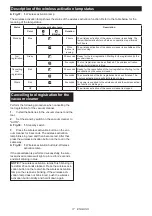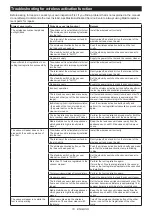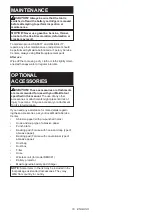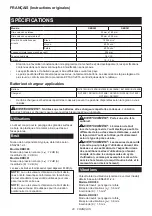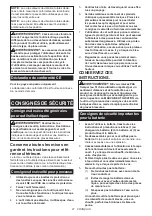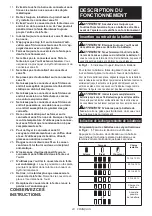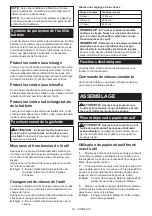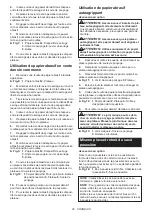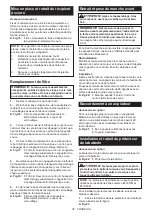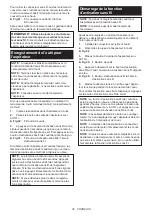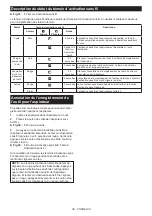
14 ENGLISH
1.
Loosen and remove the four screws securing the
pad to the sanding base.
2.
Replace the standard-equipped pad with an
optional hook-and-loop pad.
3.
Re-tighten the screws firmly to secure the hook-
and-loop pad.
►
Fig.11:
1.
Screws
2.
Sanding base
3.
Pad
4.
Remove all dirt and foreign matter from the hook-
and-loop pad.
5.
Attach a sheet of optional hook-and-loop abrasive
paper to the pad, aligning the dust-suction holes in the
paper with those in the pad.
►
Fig.12:
1.
Abrasive paper
2.
Pad
3.
Dust-suction
holes
6.
To remove the abrasive paper, peel it off from the
edge.
CAUTION:
The O ring may come out of the
sanding base while replacing the pad. Set the O
ring back in the circular grooves around the cen-
ter of the base before installing the optional pad.
►
Fig.13:
1.
O ring
2.
Sanding base
3.
Circular
grooves
Installing and removing dust bag
Optional accessory
Attach the dust bag over the tapered dust spout at the
back end of the motor housing. Put the dust inlet of the
bag onto the dust spout as far as it will go to avoid it
from coming off during operation.
►
Fig.14:
1.
Dust spout
2.
Dust inlet
3.
Dust bag
NOTE:
Make sure to attach the dust bag with its
zipper slider facing downwards.
NOTE:
To ensure optimal dust collecting, empty the
dust bag when it becomes filled to approximately half
of its capacity.
Remove the dust bag from the tool and pull the fas-
tener out. Then gently shake or tap the dust bag to
empty.
Installing and removing dust box
Optional accessory
Attach the dust box over the tapered dust spout at the
back end of the motor housing. Put the dust nozzle onto
the dust spout as far as it will go to avoid it from coming
off during operation.
►
Fig.15:
1.
Dust spout
2.
Dust nozzle
3.
Dust box
NOTE:
To ensure optimal dust collecting, empty the
dust box when it becomes filled to approximately half
of its capacity.
1. Remove the dust box from the tool.
2. Detach the dust nozzle from the box while
pressing and holding the locking latches on both
sides of the box.
3. Gently shake or tap the dust box to empty.
Replacing filter
NOTICE:
Be aware to align the logos on all the
dust box, filter and dust nozzle in a consistent
orientation when reassembling components.
1.
Remove the dust box from the tool.
2.
Detach the dust nozzle from the box while press-
ing and holding the locking latches on both sides of the
box.
►
Fig.16:
1.
Dust nozzle
2.
Dust box
3.
Locking latch
3.
Hold the inner top edge of the cardboard opening,
and pull it off downwards to disengage the outer top
edge of the cardboard opening from the upper hooking
tab on the lip of the dust box.
4.
Take the filter out of the dust box while pulling the
outer bottom edge of the cardboard opening free from
the lower hooking tab.
►
Fig.17:
1.
Filter
2.
Cardboard opening
3.
Upper
hooking tab
4.
Lower hooking tab
5.
Dust
box
5.
Replace a filter by engaging the bottom edge of
the cardboard opening in the lower hooking tab and
push the top edge inwards until it clips into the upper
hooking tab .
►
Fig.18:
1.
Filter
2.
Cardboard opening
3.
Upper
hooking tab
4.
Lower hooking tab
5.
Dust
box
6.
Snap the dust nozzle into place while pressing
and holding the locking latches on both sides of the dust
box.
►
Fig.19:
1.
Dust nozzle
2.
Dust box
3.
Locking latch
Removing and installing front grip
CAUTION:
After reassembly, pull the front
grip to check if it is securely attached together.
NOTICE:
Make sure to push the front grip fully
into the slot end and keep it positioned where it is
while rotating the front grip.
Failure to do so may
cause damage to the tool.
By removing the detachable front grip, sanding opera
-
tion in tight, confined and hard-to-reach areas can be
performed effectively.
Uninstallation
Push and hold the front grip firmly towards the motor
housing and rotate it 90 degrees to either the left or
right. Then pull it apart from the tool.
Installation
Insert the end of the front grip into the slot on the motor
housing, aligning the outlines of the grip end with those
of the slot.
Push and hold the front grip firmly towards the housing
and rotate it 90 degrees with its gripping surface facing
upwards.
►
Fig.20:
1.
Front grip
2.
Slot
3.
Motor housing
4.
Gripping surface
Summary of Contents for DBO380
Page 2: ...2 1 2 3 Fig 1 1 2 Fig 2 1 2 3 Fig 3 1 Fig 4 1 2 3 5 4 1 4 5 2 3 Fig 5 1 2 3 Fig 6 ...
Page 5: ...5 1 2 3 3 Fig 19 1 2 3 4 Fig 20 1 2 3 4 Fig 21 1 Fig 22 Fig 23 2 1 Fig 24 ...
Page 6: ...6 Fig 25 Fig 26 Fig 27 Fig 28 1 Fig 29 1 2 3 4 Fig 30 ...
Page 7: ...7 1 2 3 Fig 31 1 Fig 32 1 2 1 2 Fig 33 Fig 34 1 Fig 35 ...
Page 8: ...8 1 2 Fig 36 1 Fig 37 1 Fig 38 1 2 1 2 Fig 39 ...
Page 127: ...127 ...

















